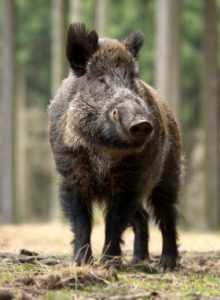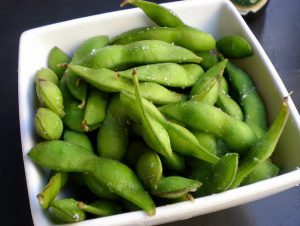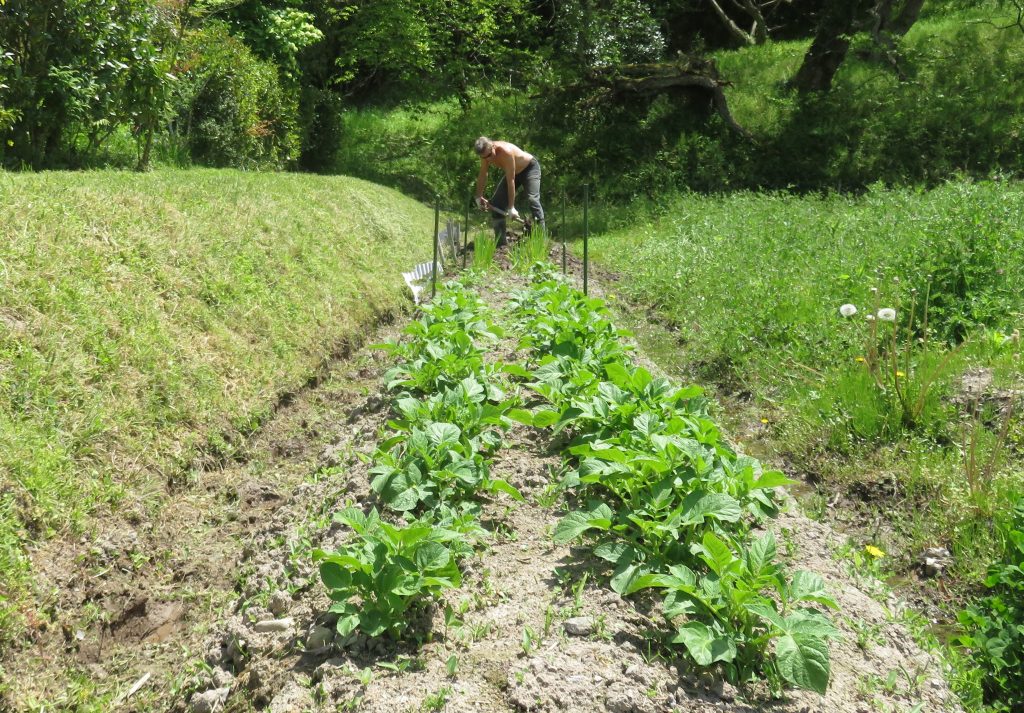 Sasayama, the traditional rural town I live in, is famous throughout Japan for two food items.
Sasayama, the traditional rural town I live in, is famous throughout Japan for two food items.
One is wild boar. We even have a wild boar festival! Can’t say I get very excited about wild boar, either in the wild, or tearing up the local farm land, or on the plate. Cooked it looks like pork but to my taste buds has a weird flavor.
The other item is black beans, better known as soybeans.
Soybeans are eventually harvested in two stages. When they first mature, they are green and relatively soft. They are best eaten fresh, right off the vine, boiled for 12-15 minutes.
 When you go to a Japanese restaurant and order edamame — 枝豆 — this is what you’re eating. They are served in the pod, which is boiled and lightly salted, and you pop the green beans into your mouth. Delicious! And nutritious!
When you go to a Japanese restaurant and order edamame — 枝豆 — this is what you’re eating. They are served in the pod, which is boiled and lightly salted, and you pop the green beans into your mouth. Delicious! And nutritious!
Many of the soybeans are left on the vine to mature to the second stage of harvesting. They become very dry and extremely hard, and they turn BLACK! The advantage is that these can be stored without refrigeration and used throughout the year for a whole variety of recipes. Black beans are even extensively used in very sweet soups and pastries.
Regardless of whether they end up as “immature” young green beans or black beans, the whole business starts in spring with the planting. My wife Masumi and I even get in on the action, planting a couple rows we rent from our neighbor.
 Fasten your seat belts. The excitement builds fast as we make some holes, then insert greenhouse-grown seedlings, push the dirt back in the hole, wait, read a book, build an atomic submarine in a bottle out of used match sticks, wait some more, fertilize the plant a couple times in the summer, keep waiting (patience is very important in farming) as momentum on the soybean growing scene steadily keeps gathering steam. Did I mention there’s quite a bit of waiting involved? Then finally sometime in October it all climaxes in a earth-shaking, rib-rattling, jaw-dropping, game-changing finale (I’ve dedicated a separate article to the harvest).
Fasten your seat belts. The excitement builds fast as we make some holes, then insert greenhouse-grown seedlings, push the dirt back in the hole, wait, read a book, build an atomic submarine in a bottle out of used match sticks, wait some more, fertilize the plant a couple times in the summer, keep waiting (patience is very important in farming) as momentum on the soybean growing scene steadily keeps gathering steam. Did I mention there’s quite a bit of waiting involved? Then finally sometime in October it all climaxes in a earth-shaking, rib-rattling, jaw-dropping, game-changing finale (I’ve dedicated a separate article to the harvest).
Whew! I’m surprised they haven’t made a Movie-of-the-Week out of it.
Anyway, sarcasm notwithstanding, the soybean fields are quite beautiful. And the farmers are very hard-working folks. Masumi and I are hobbyists. The growers are the real deal.




Life In Japan: Planting Soybeans
One is wild boar. We even have a wild boar festival! Can’t say I get very excited about wild boar, either in the wild, or tearing up the local farm land, or on the plate. Cooked it looks like pork but to my taste buds has a weird flavor.
The other item is black beans, better known as soybeans.
Soybeans are eventually harvested in two stages. When they first mature, they are green and relatively soft. They are best eaten fresh, right off the vine, boiled for 12-15 minutes.
Many of the soybeans are left on the vine to mature to the second stage of harvesting. They become very dry and extremely hard, and they turn BLACK! The advantage is that these can be stored without refrigeration and used throughout the year for a whole variety of recipes. Black beans are even extensively used in very sweet soups and pastries.
Regardless of whether they end up as “immature” young green beans or black beans, the whole business starts in spring with the planting. My wife Masumi and I even get in on the action, planting a couple rows we rent from our neighbor.
Whew! I’m surprised they haven’t made a Movie-of-the-Week out of it.
Anyway, sarcasm notwithstanding, the soybean fields are quite beautiful. And the farmers are very hard-working folks. Masumi and I are hobbyists. The growers are the real deal.